Intel opened its Intel Innovation conference Tuesday by finally unveiling what everyone has been waiting for: how fast its new 12th-gen “Alder Lake” desktop Core chips will be, and how much they’ll cost. The flagship, the Intel Core i9-12900K, will be the “world’s best gaming processor,” Intel executives said; it will be priced $50 higher than the last-gen Core i9-11900K at launch, too.
Perhaps not surprisingly, there won’t be that much variety to Intel’s first “performance hybrid” processors: just six new chips, which won’t even include a Core i3 processor. By contrast, Intel launched 19 new 11th-gen “Rocket Lake-S” processors back in March, which will conceivably fill any gaps in Intel’s 12th-gen portfolio.
(At the Intel Innovation event held Wednesday in San Francisco, Gregory Bryant, executive vice president and general manager of the Client Computing Group, said that there eventually be 60 new processors in the Alder Lake family.. Bryant said that Intel is currently shipping 28 versions of Alder Lake to PC makers.)
Alder Lake does have some unexpected twists. For one, Intel released data showing that Alder Lake can significantly outperform an earlier 11th-gen Rocket Lake chip when tasks are run concurrently, rather than one after the other. Alder Lake’s support for faster, pricier DDR5 has been known, but a new dynamic XMP memory overclocking feature adds an unforeseen twist. Intel has also added simple overclocking: click a software control, and you’ll get hundreds of additional megahertz for free.
Here are Intel’s new Alder Lake chips
As we described in August, Intel’s Alder Lake chips now include two different types of cores: fast “performance cores,” and slower, less power-hungry, “efficiency” cores. Within the six new Alder Lake chips, the performance cores will run from a base speed of 3.2GHz on up 3.7GHz, with turbo speeds topping out at 5.2GHz. That’s just a tick slower than the 5.3GHz that the Core i9-11900K achieved.
Even summarizing the six new processors now presents far more of a challenge than before, though we’re boiling it down to just three. Each of the “K” variants listed below includes the new integrated UHD Graphics 770 GPU. For each, a separate “KF” variant cuts out the GPU in favor of a discrete GPU, sold separately. (Incidentally, Intel didn’t mention its discrete Intel Arc GPU, scheduled for an early 2022 launch.) Each of the new chips appears to be more expensive than the launch prices of their 11th-gen Rocket Lake counterparts, with more of a premium on the high-end processors.
- Core i9-12900K: 16 cores/24 threads (8 performance cores at 3.2GHz (base)/5.2GHz (turbo), 8 efficiency cores at 2.4GHz (base)/3.9GHz (turbo))
- Core i7-12700K: 12 cores/20 threads (8 performance cores at 3.6GHz/5.0GHz, 4 efficiency cores at 2.7GHz/3.8GHz)
- Core i5-12600K: 10 cores/16 threads (6 performance cores at 3.7GHz/4.9GHz, 4 efficiency cores at 2.8GHz/3.6GHz)
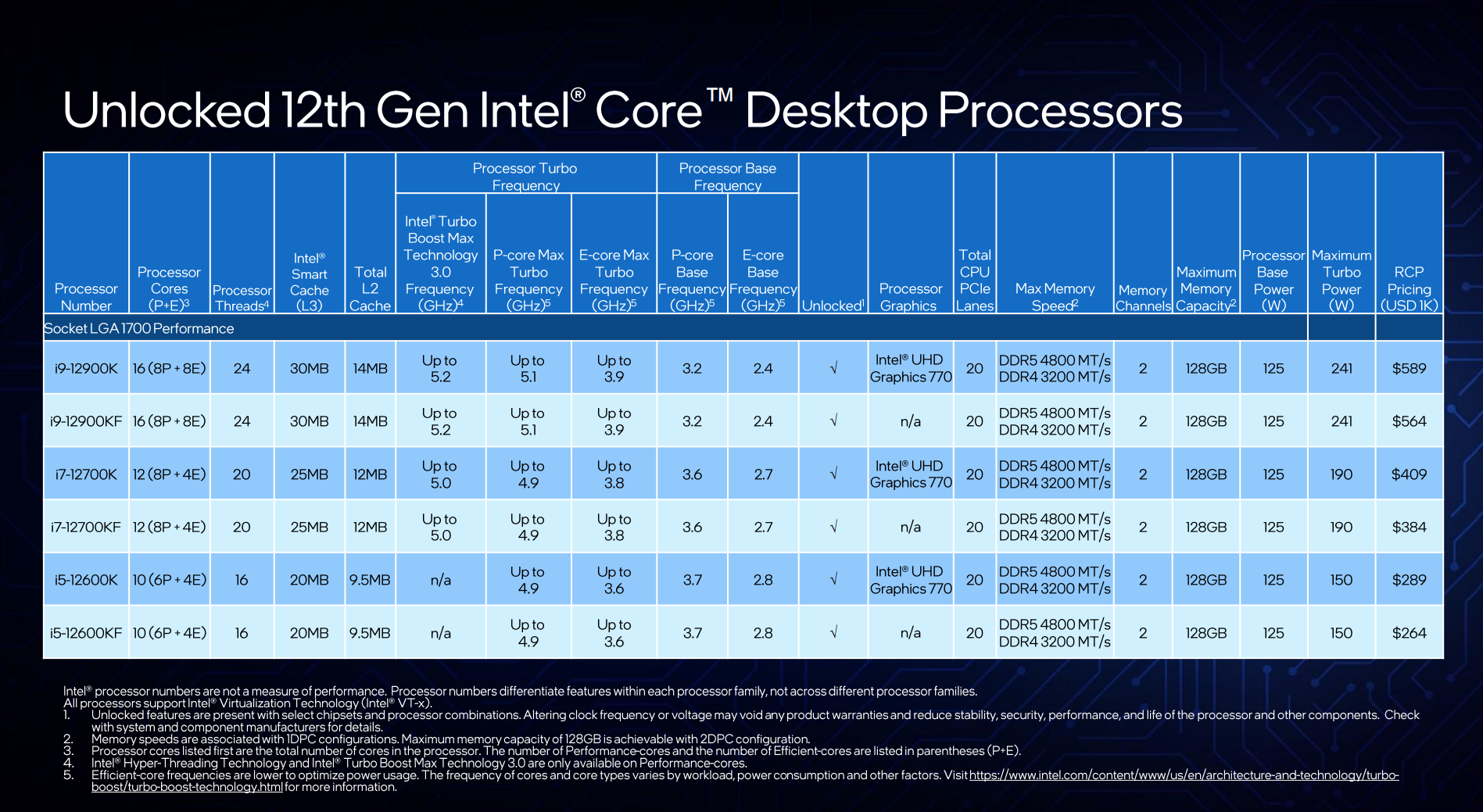
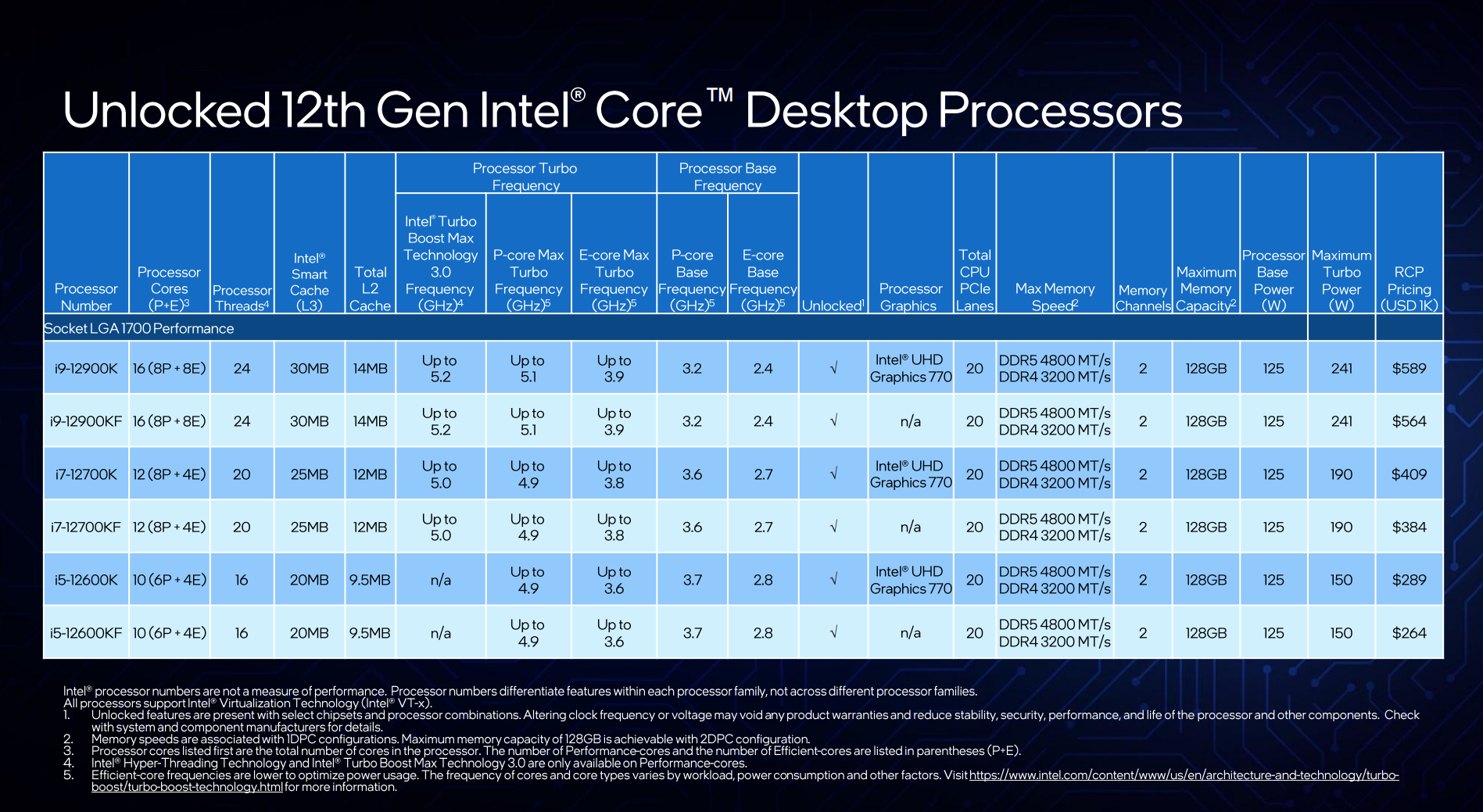
Intel
Interestingly, the “slower” Alder Lake chips will run at higher base clock speeds than their more expensive, higher-performance counterparts. These cheaper chips offer less of a differential between the base clocks and the faster turbo speeds. Unfortunately, Intel isn’t offering an all-performance-core Alder Lake as it hinted earlier.
You should note, too, that while these are all technically 125W chips, Intel has tossed out the term “thermal design power (TDP)” in favor of “processor base power (PBP).” And that has a caveat, too. Though the PBP on all of these is 125W, PC coolers will need to account for a “maximum turbo power”: the Core i5-12600K/KF’s turbo power is 150W, the Core i7-12700K/KF max turbo power is 190W, and the Core i9-12900K/KF is 241W. All are manufactured on Intel’s Intel 7 process technology.
As you might expect, Intel is launching the desktop versions of its 12th-gen Alder Lake chips first. Mandy Mock, Intel’s vice president and general manager of the desktop, workstation, and channel group within Intel, said that Intel’s partners will support the launch of Alder Lake with 60 different motherboards.
About 140 customers will ship 12th-gen-powered PCs by the end of the year, she added, with over 100 new desktop designs from all-in-ones to small-form-factor PCs to debut in 2022. That’s the same timeframe as mobile and ultramobile (tablet) versions are expected to arrive, probably around when the CES conference opens in January 2022. According to Bryant, PC makers will receive the mobile versions of Alder Lake next month.
Performance, with an eye toward multitasking
Intel told us in August that we should expect an overall 19 percent gen-over-gen improvement with the 12th-gen Alder Lake versus the 11th-gen Rocket Lake chips, and that still holds true. Now, however, we have some more specifics.
In terms of the Alder Lake performance core, Intel is now saying that the 12th-gen Alder Lake performance core is 28 percent faster than the 10th-gen Comet Lake-S processor, and that the 11th-gen Rocket Lake-S chip was 12 percent faster than Comet Lake. Applying a little math, that means that the 12th-gen Alder Lake’s P-core is 14 percent faster than the 11th-gen Rocket Lake-S.

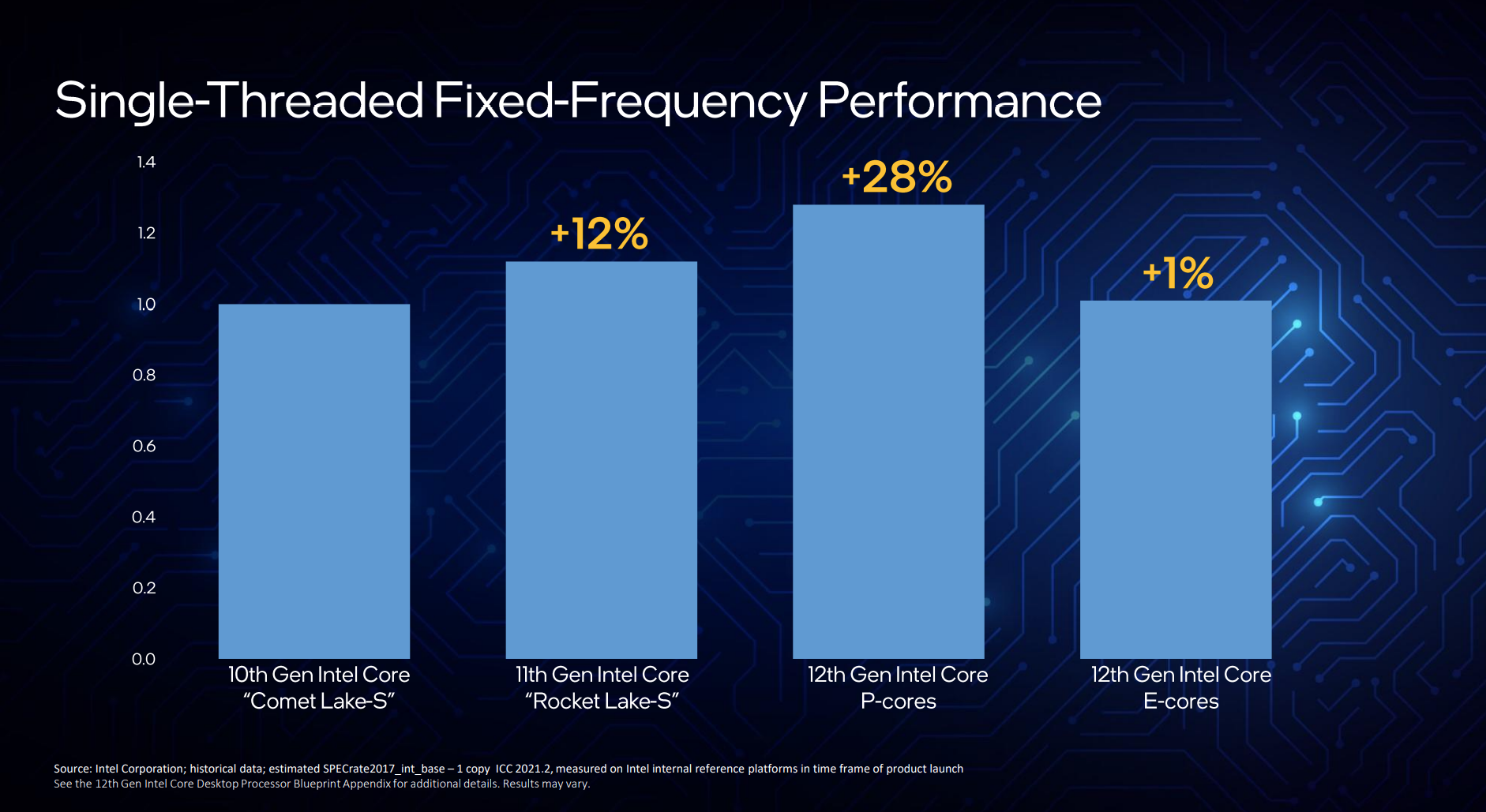
Intel
Marcus Kennedy, the general manager of Intel’s gaming, creator, and e-sports segment, also reiterated that the 12th-gen Alder Lake “efficiency” core is about 40 percent faster than Intel’s sixth-generation Core, Skylake. The 12th-gen Alder Lake’s E-core is about 1 percent faster than the 10th-gen Comet Lake, or about a 10 percent dip in performance from the 11th-gen Rocket Lake-S.
PC makers, of course, have the option to run Alder Lake at lower power levels. Guy Therien, an Intel fellow, noted that the Core i9-12900K can be run at 65W, and still deliver the performance of the Core i9-11900K at 250W. That’s a massive power savings, especially when future mobile processors come into play.
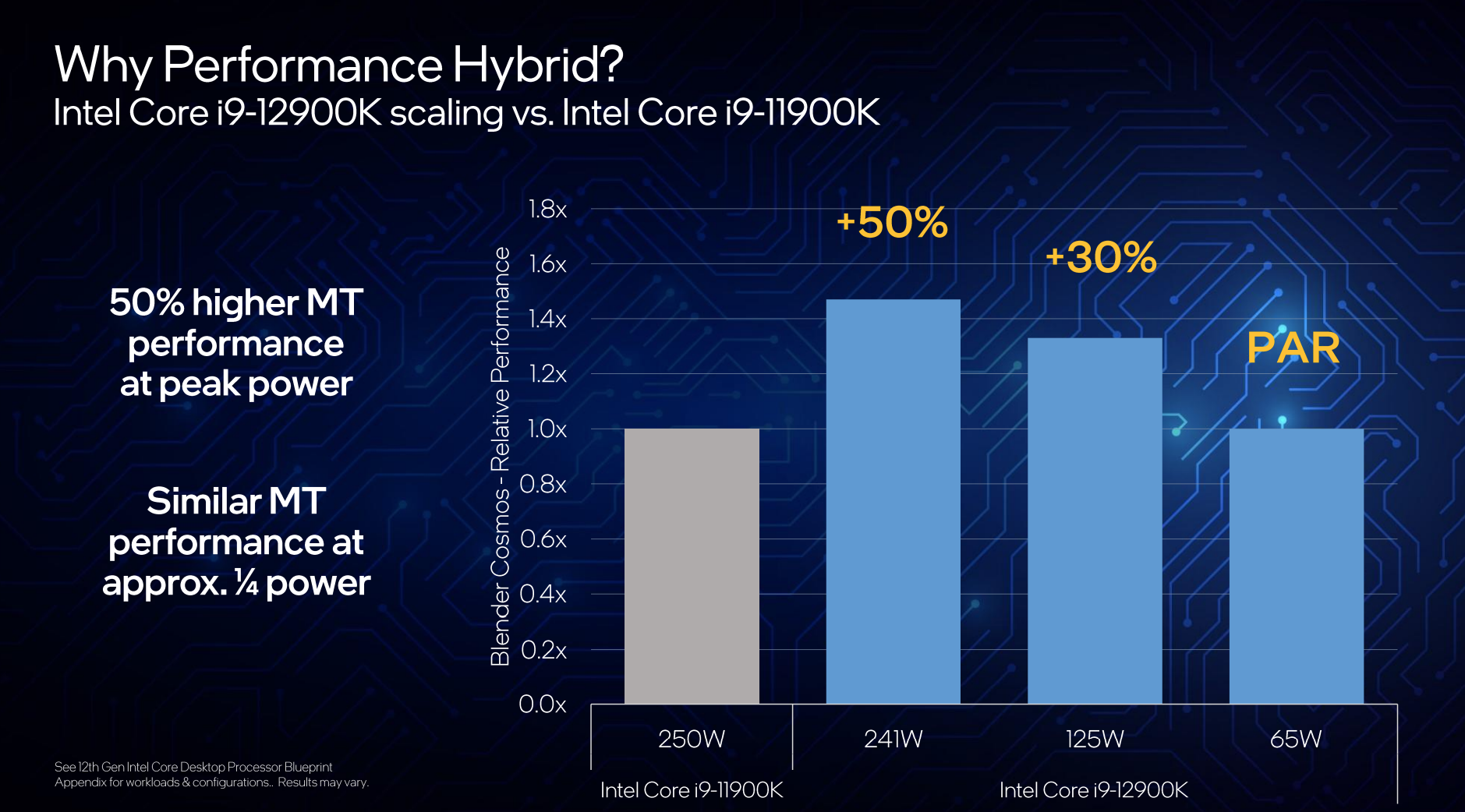
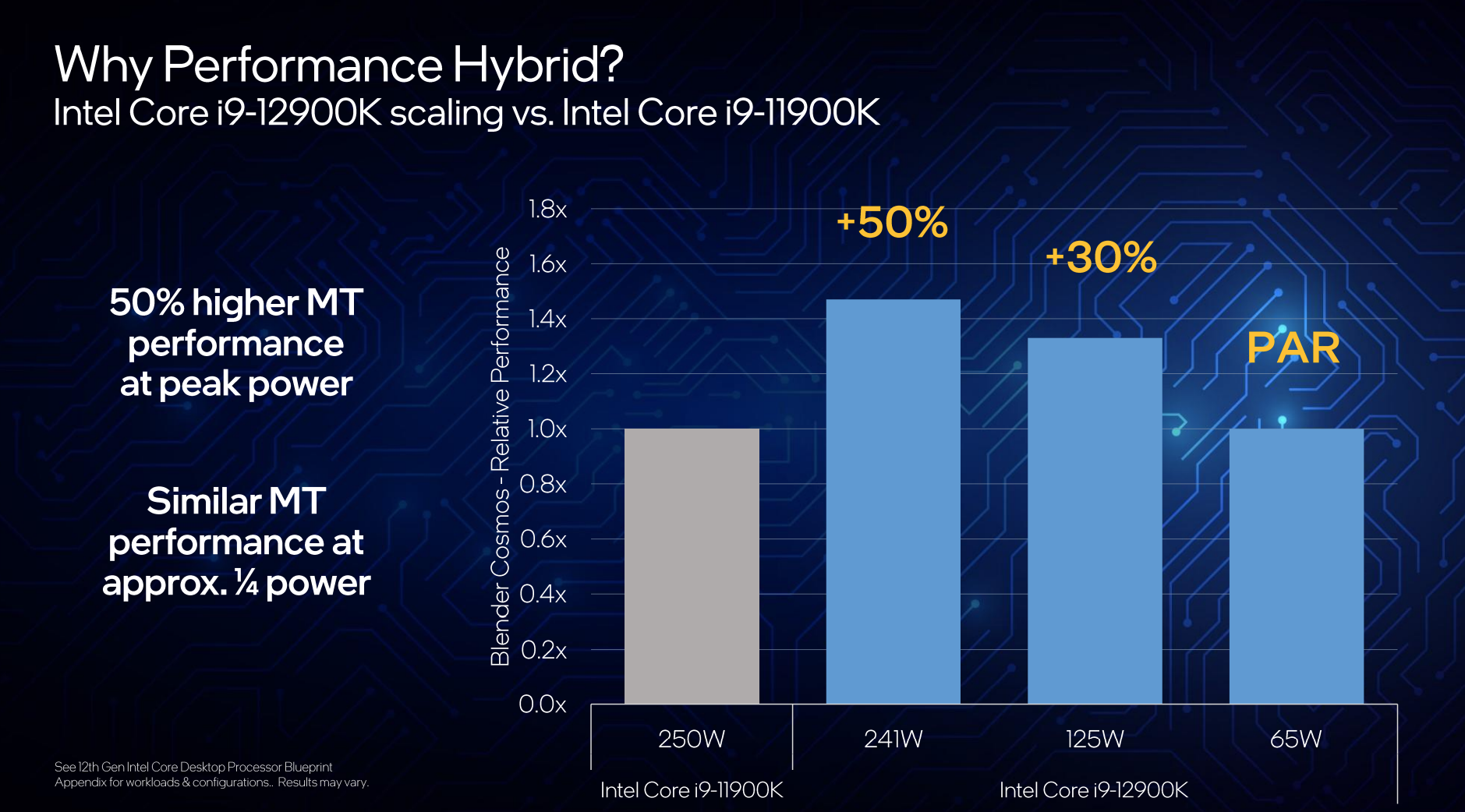
Intel
What’s new on the performance front are two things: First, Intel typically provides much more detail about how fast the processor runs in specific games at launch, and it did so today in comparisons to its existing 11th-gen processor as well as AMD’s desktop processor from last year, the Ryzen 5950X. Second—an idea which Intel has been talking about for some time—is that Alder Lake will be a processor whose performance and efficiency cores will be particularly suited to running simultaneous tasks.
In all of its gaming comparisons, Intel used a system based on DDR5 memory, the new, faster memory type that accompanies the Alder Lake generation. The other systems used DDR4. It appears that Intel’s test PC used a PCIe 4 SSD, however. All gaming comparisons used an RTX 3090 at 1080p High settings. We’ve listed a few of Intel’s comparisons below.


Intel
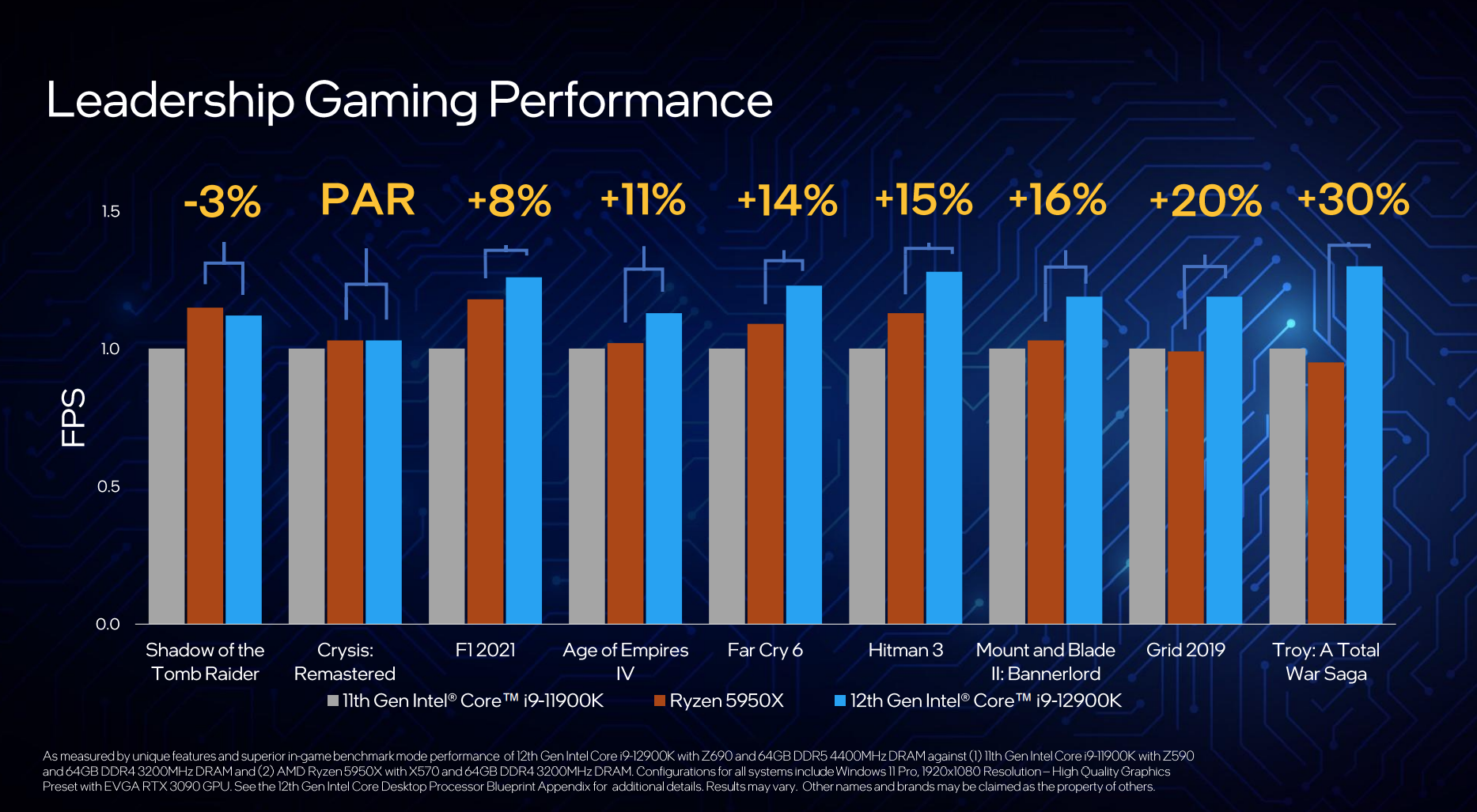
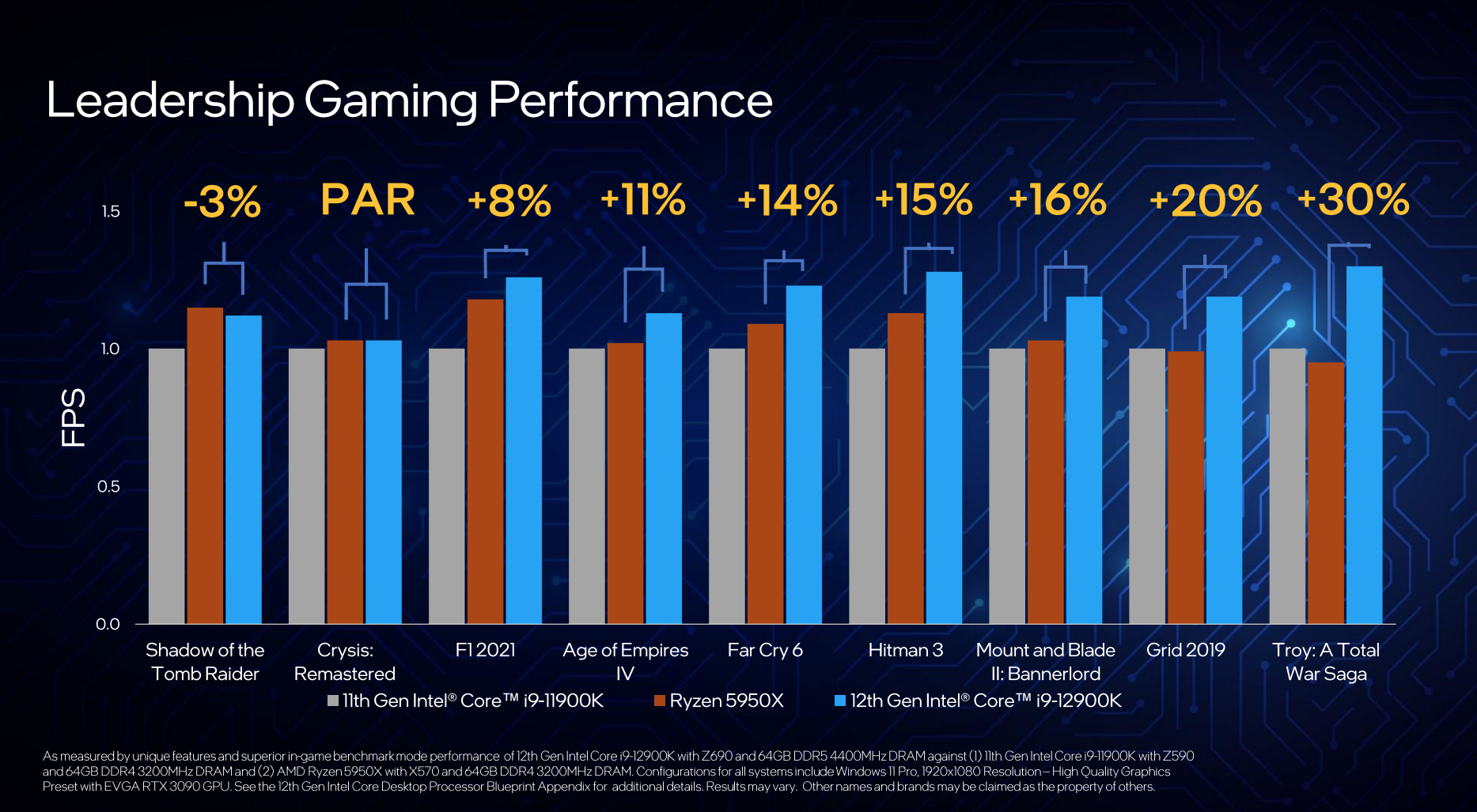
Intel

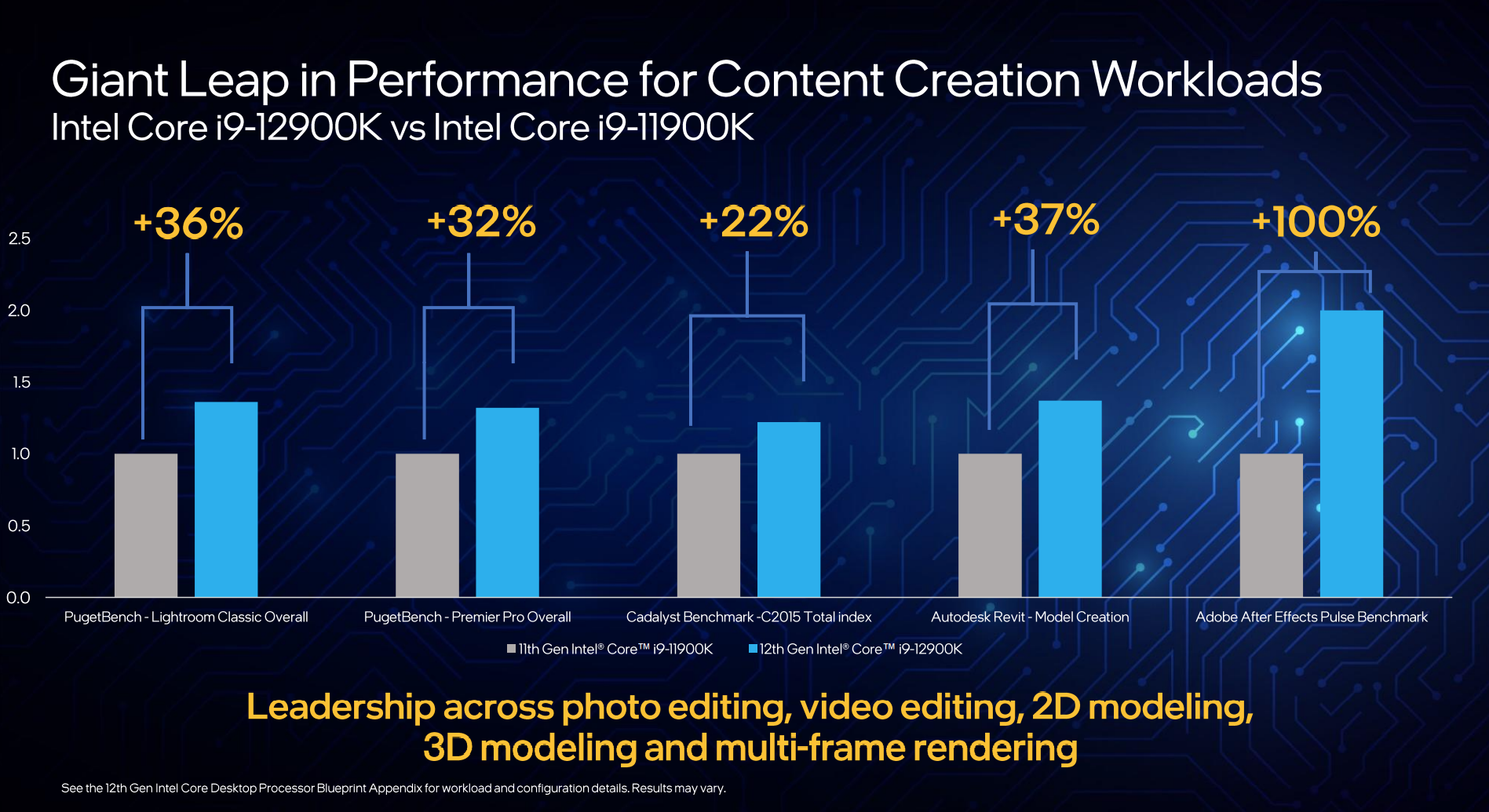
Intel
Incidentally, Intel tested the Ryzen 5950X before a bug cropped up with Windows 11 and the 5950X’s cache latency. Intel’s Kennedy said that Intel would retest its chips and re-release the results in the future.
Remember, too, that the performance of Alder Lake is managed by a new hardware technology called Thread Director, designed to work with, and already integrated into, Windows 11. Thread Director analyzes the performance needs of each thread, assigning them to the right type of core—and then re-assigning them on the fly if new threads appear. Essentially, the chip itself conveys the efficiency of certain cores to the operating system via an API. The OS then makes the decisions on which cores and instruction threads to use. Thread Director uses a model that’s been trained by AI to identify the workload classes, Therien said.
In Windows 11, Thread Director will make “better decisions on where to put certain kinds of work,” Therien said, which will enable greater performance. But in Windows 10 and Linux, Thread Director will still run, but without some of the thread-specific feedback that will improve performance within Windows 11. The overall experience is “still very great,” he added.
All of these factors add a new wrinkle to the 12th-gen Alder Lake chips: Intel believes that your PC will be faster when two tasks are run concurrently, rather than one after another. That’s a sea change from the old way of computing, when you’d run one task, then another, assigning all of the PC’s computing power to the task at hand. Intel released data showing that when Adobe Lightroom and Premier are used together (to edit photos while a video is being exported) the tasks complete faster than when run separately.
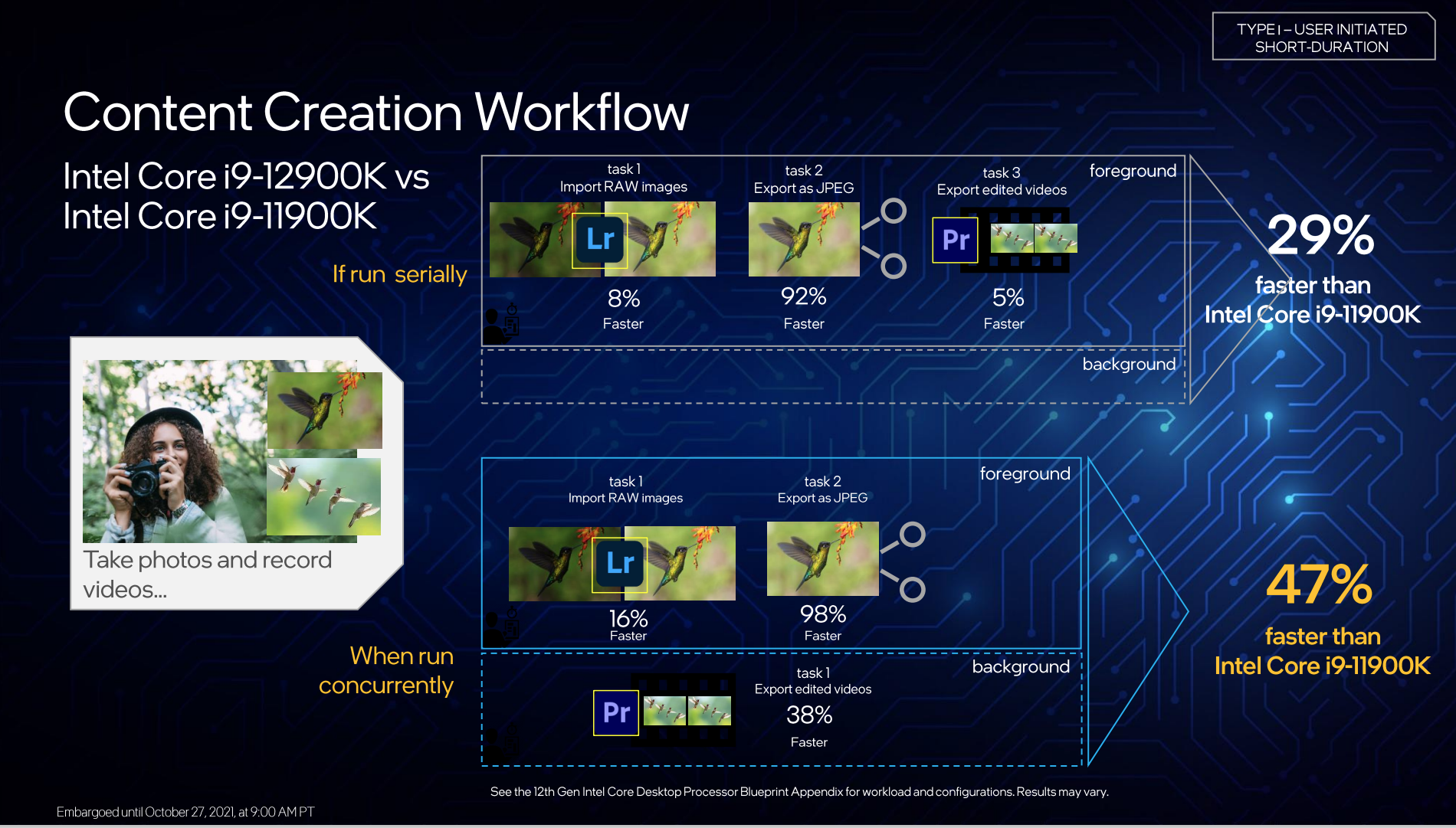

Intel
How Thread Director will work from a user perspective is still a bit confusing. When you hide an application, Windows will automatically push it to the slightly slower efficiency or E-cores, Therien said. But he also said that users will be able to configure that behavior themselves. How to do that still isn’t clear, though Therien implied that it would be governed by the Windows 11 power mode settings.
And as far as the new Apple M1 and M1 Max chips are concerned? “We’re very confident in the 12th-gen performance,” Intel’s Mock said in response.
Intel’s new Z690 chipset for Alder Lake
Normally Intel releases several chipsets in support of new processors, but for now there’s just one: the Intel Z690, manufactured on a 14nm process.
Intel’s Alder Lake platform supports several new key features, many of which Intel has discussed previously: the introduction of DDR5 memory at speeds up to DDR5-4800; support for PCI Express 5.0 as well as PCIe 4.0; plus a wider x8 DMI Gen 4.0 interface, the name for the interface between both chips and the chipset. (You’ll have the option of using cheaper DDDR4-3200 memory as well, though the overall performance won’t be quite as high.) That wider DMI interface allows more bandwidth between the CPU and the chipset, which in turn allows for more bandwidth to the various I/O interfaces. The Z690 also natively integrates Wi-Fi 6e, and adds USB 3.2 Gen 2×2 (20Gbps) for higher-speed I/O and peripherals. While Alder Lake supports Thunderbolt 4, however, it doesn’t appear that the Z690 supports it.
Here’s a block diagram of the new Z690 chipset, with some of its features. Note how there’s a mix of PCI 5.0, PCI 4.0, and PCI 3.0, and support for four independent DisplayPort or HDMI displays.

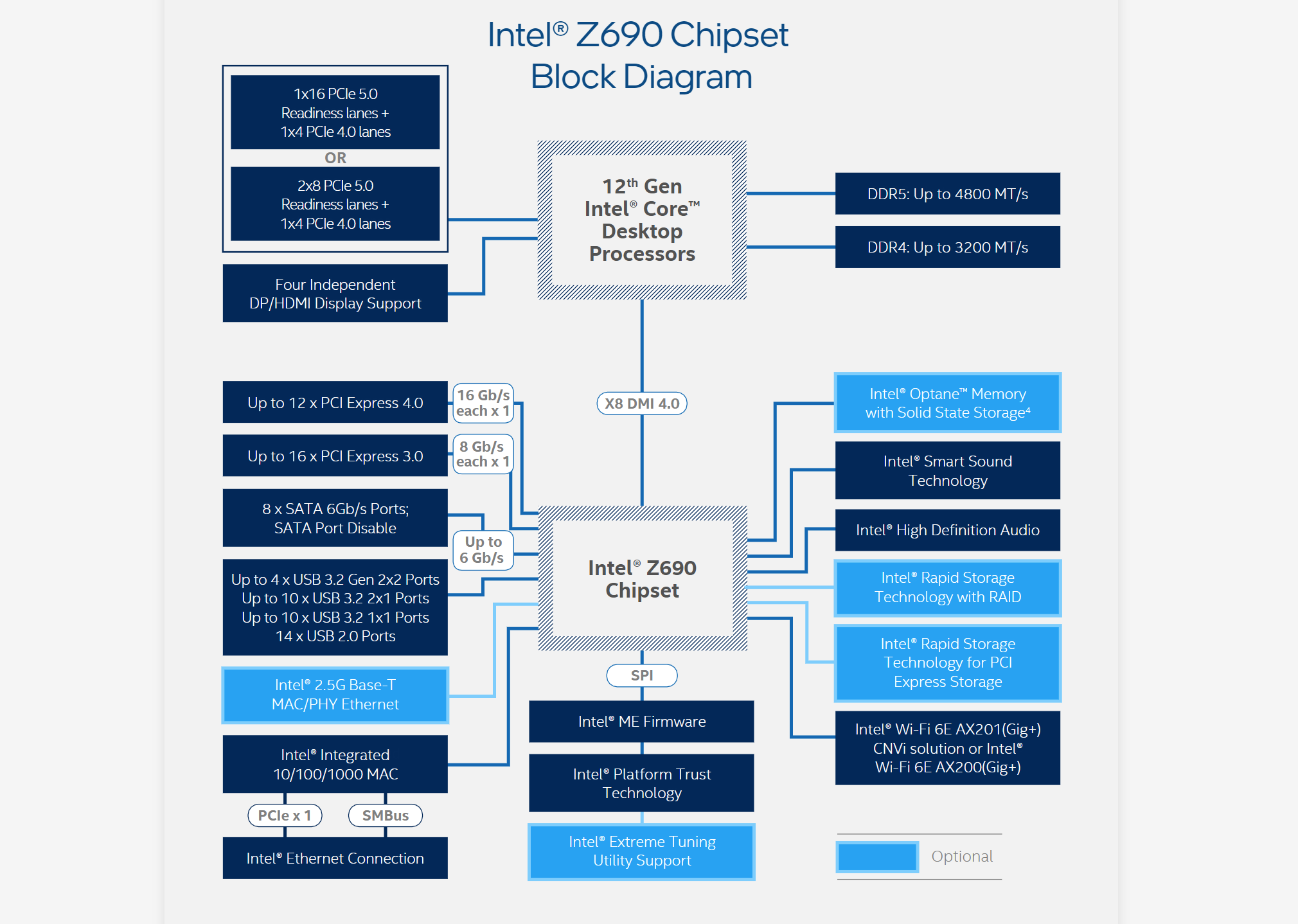
Intel
Intel hasn’t released a list of motherboards that will be designed around the Intel Z690, nor has it released the prices of those motherboards.
One-click overclocking
Intel is providing a number of tools to overclock the Alder Lake processors, many of which will probably be used by competitive enthusiasts hoping to score a few clocks higher than rivals when supercooling the chips. All of the Alder Lake “K” chis are fully unlocked, however, as is the Z690 chipset.
For most users, there’s one key addition to Intel’s Extreme Tuning Utility (XTU) that will be of interest: one-click overclocking with the Intel Speed Optimizer. The Windows-only app will automatically handle the behind-the-scenes adjustments of speed and voltage, so that the utility will “safely” overclock your system by a small amount.
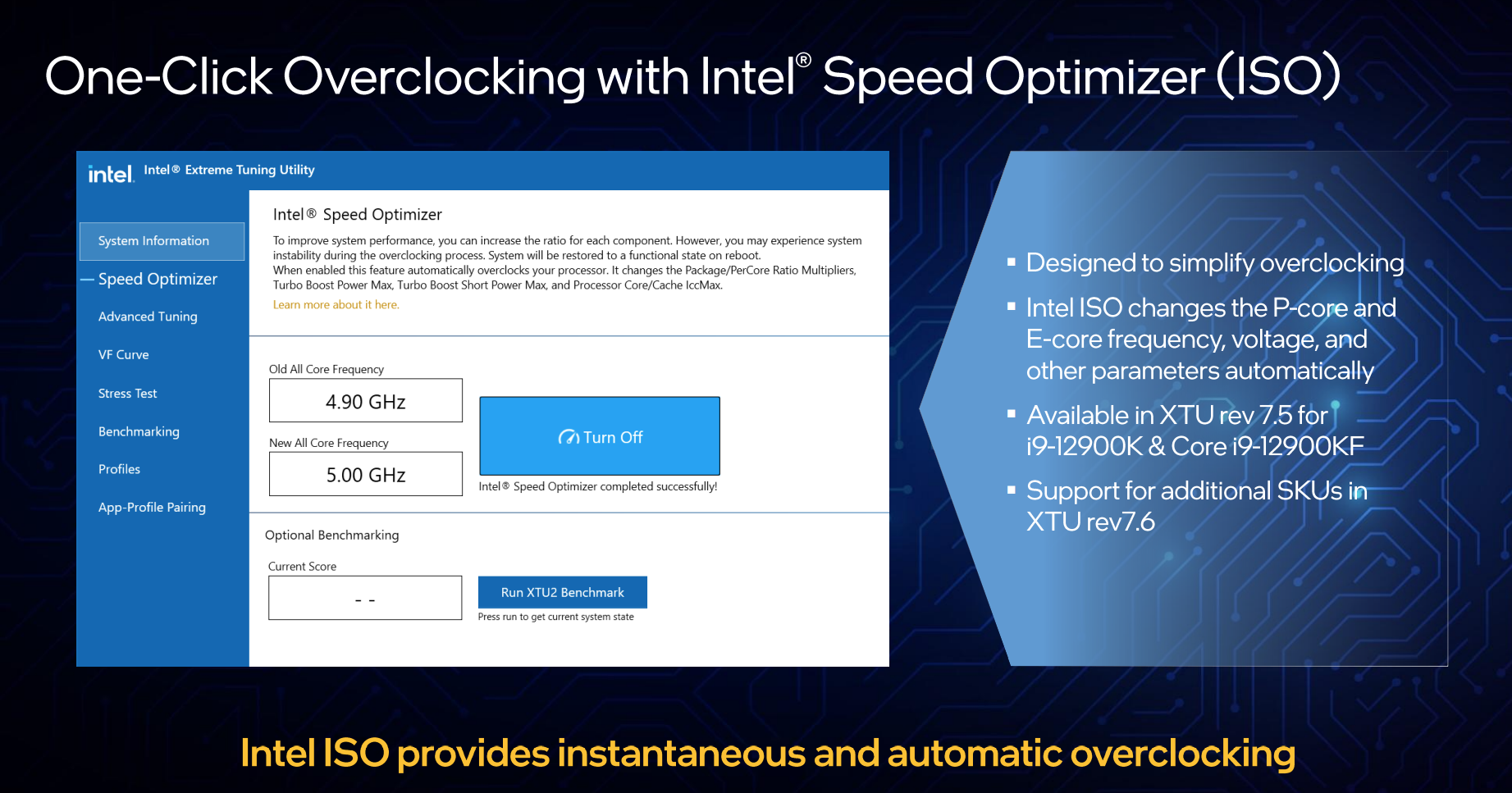

Intel
Dan Ragland, the principal engineer overseeing the feature, showed how the tool overclocked an unnamed Intel processor from 4.9GHz to 5.0 GHz on the performance cores, and from 3.7GHz to 4.0GHz on the efficient cores. (It’s likely that Ragland was referring here to the Core i9-12900K/KF, since that’s the only processor supported by XTU rev. 7.5. However, the i9-12900K doesn’t support efficiency core clock speeds of either 3.7GHz or 4.0GHz. We asked Intel for further clarification. Support for additional Alder Lake chips will be added to Intel Speed Optimizer in XTU 7.6, Ragland said.)
For now, Speed Optimizer’s 100MHz overclock on the P-cores, and the 300MHz overclock on the E-cores, will be a standard feature on all Alder Lake processors. Put another way, the Intel Speed Optimizer is a “universal” overclock that will be applied to all Alder Lake chips. Ragland did note, however, that using the Speed Optimizer tool will raise the voltage out of the approved specified limits.
Ragland did not specifically say that this will void your warranty, but certainly implied it. On the other hand, Intel’s Mock noted that the Intel recently eliminated its optional warranty program on overclocked parts “because we saw so few claims against it,” she said. “The quality of the parts is quite good, and so we didn’t need it.”
Users will have the option of tweaking their processors on a case-by-case basis as well, as individual chips will have their own individual tolerances. Performance cores can be individually controlled, though efficiency cores can only be controlled in blocks of four. Intel will support ring (cache) ratios, graphics frequency ratios, as well as controls over memory ratios, for both DDR4 and DDR5, Ragland said. Intel will also offer features specific to overclocking in certain scenarios, such as the ability to turn off AVX instructions as well as a feature to disable hyperthreading.
Intel has also added XMP 3.0 support to enable overclocking DDR5 memory, in a similar fashion to the way in which XMP already allows for overclocking DDR4 memory. Intel has also increased the number of profiles (a combination of frequency, latency, and voltage) from two options to five. (Three profiles will be provided by the vendor, while two can be configured by the user.)
What’s rather neat, though, is how Intel has combined the two with something it calls Dynamic Memory Boost technology. Previous XMP implementations required the user to toggle between the default memory speed and the XMP memory state. Dynamic Memory Boost does it automatically and intelligently, scaling the memory speed up and down depending on the demands of the system. “Think of this as memory turbo,” Ragland said. “It’s automatic.”
This story was updated at 9:36 AM with additional details as Intel announces Alder Lake from its Intel Innovation conference.
Note: When you purchase something after clicking links in our articles, we may earn a small commission. Read our affiliate link policy for more details.
As PCWorld’s senior editor, Mark focuses on Microsoft news and chip technology, among other beats. He has formerly written for PCMag, BYTE, Slashdot, eWEEK, and ReadWrite.
Leave a Reply Cancel reply
document.addEventListener(‘DOMContentLoaded’,function(){var commentForms=document.getElementsByClassName(‘jetpack_remote_comment’);for(var i=0;i<commentForms.length;i++){commentForms[i].allowTransparency=false;commentForms.scrolling='no';}}); <!–
